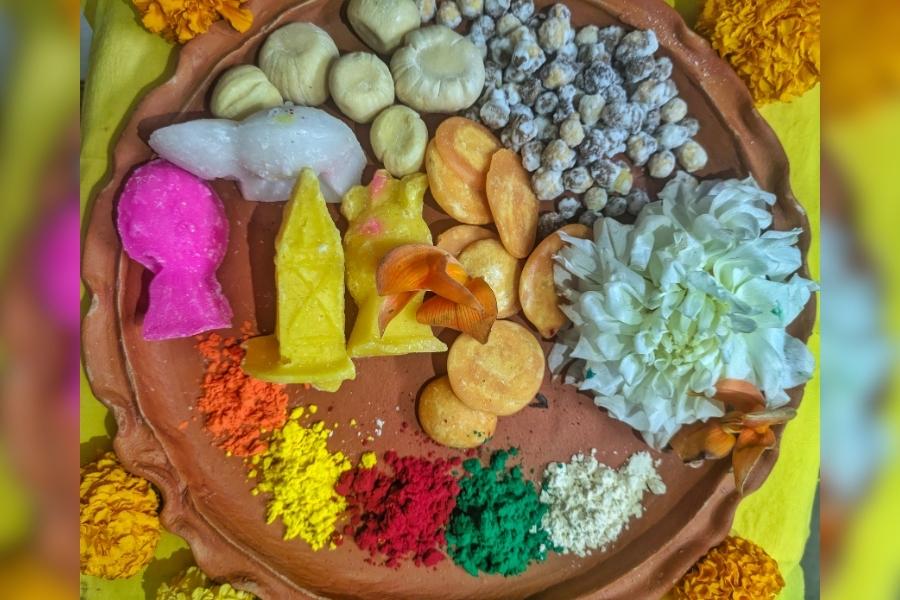 Thursday, 13 March 2025
Thursday, 13 March 2025
 Thursday, 13 March 2025
Thursday, 13 March 2025

1.Satyajit Ray rated this film among the most important early Bengali sound films and regarded the director as the first genuine purveyor of Bengali social comedies. This film director’s formal training in the visual arts, literature and photography often yielded dexterous combinations of witty dialogue, inventive acting and a fluid narrative style that rarely resorted to middle-class sentimentalism while evoking, with a sense of self-mockery, its manners and conversational culture. He did several significant films with Bhanu Bandyopadhyay. Who is the director we are talking about?
Sourced by the TelegraphNirmal Dey, who directed Basu Paribar, Sare Chuattor, Champadangar Bou, Nirdharito Shilpir Anuposthite among other notable ones. He was also the writer of the very popular Hindi movie Shagird starring Joy Mukerjee, Saira Banu and I.S. Johar.
Dinabandhu Mitra wrote Jomalaye Jibonto Manush, the basic storyline which will later be adopted into an eponymous film starring Bhanu Bandyopadhyay and Basabi Nandi.
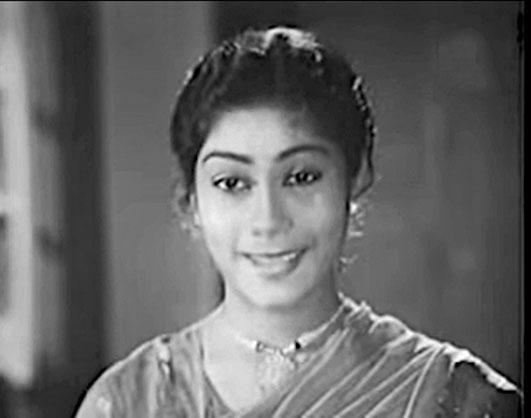
3. Proud mother of one of the finest theatre personalities in Bengal and grandmother of a National Award-winning actor, she herself is a powerhouse of talent and people hate her in Shreemoyee. She had a brief appearance (shown in the picture) in Bhanu Bandyopadhyay’s movie Personal Assistant which was her third venture on the celluloid. Who is she?
Sourced by the TelegraphChitra Sen, mother of Kaushik Sen and grandmother of Riddhi Sen. She won the 2010 Best actress award from the Government of West Bengal for her role in Jalchhabi.
Sabitri Chatterjee. Bhanu Bandyopadhyay gave Sabitri Chatterjee her first break on the stage in the play Notun Ihudi, a play of Uttar Sarathi group theatre on the refugees from East Pakistan. The play was being directed by Kanu Banerjee, who is remembered for his performance in Ray’s Pather Panchali.
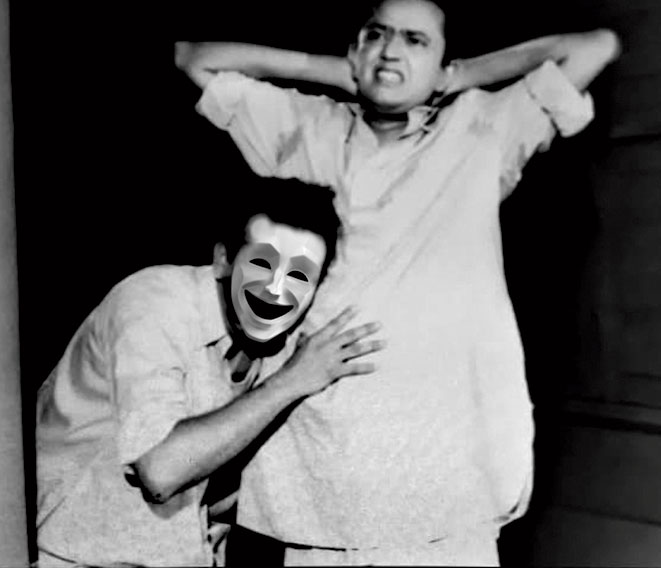
5.This movie had Bhanu and another brilliant actor in the lead roles. The film also had a cameo by Anup Kumar and Jahar Roy. It’s print was in a bad shape till very recently when it got restored on DVD. Who is Bhanu Bandyopadhyay’s co-actor in this scene whose face has been masked?
Sourced by the TelegraphKali Banerjee. The name of the movie is Ogo Shunchho.
6. In a classic audio-drama Bhanu Bandyopadhyay as husband says to his wife that diseases used to have names sounding ‘Ya Ya’ — like pneumonia, malaria, anaemia, diphtheria... Now we have diseases which sound like ‘Is’ — pharyngitis, conjunctivitis, encephelitis... “And when doctors cannot figure out the disease they talk about something sounding like ‘us’.” What was the term he referred to?
Virus.
Bhanu Bandyopadhyay’s wife Nilima Bandyopadhyay was a prolific singer herself. These three films are among her notable contributions as a playback singer.
8.In 1967, Bhanu appeared in a fantasy which was about getting back one’s youth by taking a dip in a magical pond. Years later, an English movie had a similar concept and earned two Academy Awards for Best Supporting Actor and Best Visual Effects. It was also about a swimming pool charged with life forces that gave elderly couples the pleasure of feeling young once again. What was the Bengali movie and English one?
The Bengali movie was Ashite Ashio Na and the English one was Cocoon, directed by Ron Howard.
When the clue is in the picture
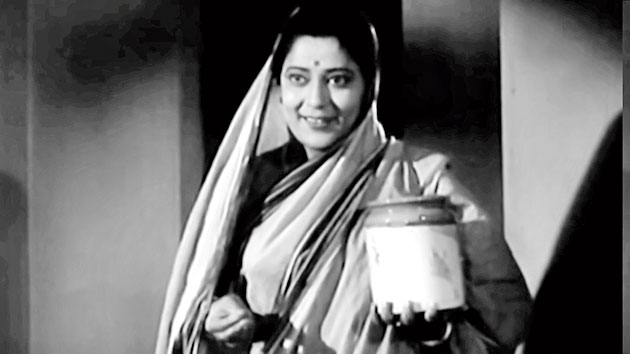
1. It needs one dialogue to make a legend out of a thespian. There are the violent ones like ‘Kitney aadmi the’ and the romantic ones like ‘Bade bade deshon mein …’ To Bengalis, it was a hilarious one: ‘Masima, malpo khamu’. Who played this masima from whom Bhanu Bandyopadhyay fondly demanded a malpo?
Sourced by the TelegraphPadma Devi, who was one of the earliest action heroines of the Indian Cinema and later stunned the audience through her mother-cum-middleman act in Ray’s Jana Aranya. Here she is seen in the movie Sare Chuattor which shot Bhanu Bandyopadhyay to stardom as a comedian and character actor. Presumably, she is carrying the jar of malpos.
This scene is from Chowringhee which was based on the eponymous novel by Shankar. The scarf was for Karabi Guha, played by Supriya Devi. Karabi was found dead in her room before this scene. The colour of the scarf was Basanti or a form of yellow.
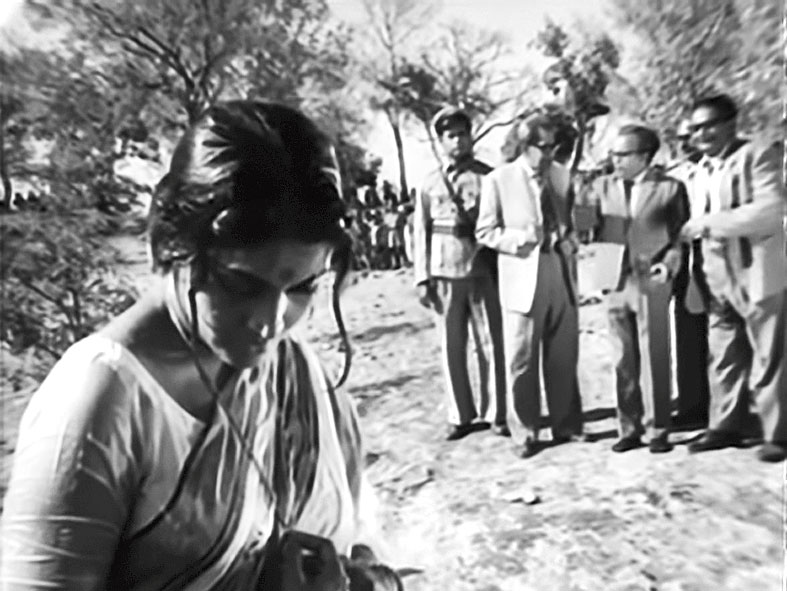
3. This was a very special moment in this cinema when the lead actress discovers a huge transformation in herself. However, even before that her husband had already discovered the magic behind the transformation. What was that transformation and what was the source of the magic?
Sourced by the TelegraphThis still is from Ashite Ashio Na, directed by a unit of directors who called themselves Shree Jayadrath. In this scene, a septuagenarian character, played by Ruma Gugathakurta, discovered that she has suddenly turned sweet seventeen after taking dip in a magic pond.

4. This is another hallmark in the illustrious career of Bhanu Bandyopadhyay. Needless to say, he is playing a woman in this scene. Name the movie and the co-actor, who himself was a tremendous talent and impressed Rabindranath Tagore and Mahatma Gandhi through his songs. He was also a favourite of Satyajit Ray.
Sourced by the TelegraphThe still is from the movie Miss Priyangbada, directed by Rabi Basu and Dushmanta Chowdhury. The co-actor in this scene is Horidhon Mukhopadhyay.

5. The film that introduced Bhanu Bandyopadhyay as an unique talent was Basu Paribar. But this is a still from the movie which launched him as a lead actor. In this scene he is seen with a bunch of very talented co-stars. Identify the one to his exact left and one to his extreme right.
Sourced by the TelegraphSare Chuattor had a stellar cast. Despite the presence of Uttam Kumar and Suchitra Sen, it was out-and-out a Tulsi Chakraborty and Bhanu Bandyopadhyay show. In this scene he is accompanied by two of the most popular crooners from Bengal — Shyamal Mitra (to his extreme right) and Manabendra Mukhopadhyay (to his exact left).
his is another classic scene from Ashite Ashio Na where a father lands up in an identify crisis after suddenly getting younger. Bhanu Bandopadhyay is playing the octogenarian-turned-18 and Kamal Mitra and Asitbaran are playing his sons. As the sons fail to recognise their transformed father they are about to kick him out of the house thinking that he is an imposter and charlatan.

7. Two different movies from two completely different genres. But a very talented actor is sharing the space with two actors who are stars in their own rights – Bhanu Bandyopadhyay and Uttam Kumar. In one scene, he is seen enjoying a dose of nose powder and in the other a cup of tea. Who is this actor who was a favourite of Satyajit Ray?
Sourced by the TelegraphOne film is Nirdharito Shilpir Anuposthitite and the other is Ray’s Chiriakhana, the former being a comedy-turns-serious movie and the later is from a darker genre. The actor is Shailen Mukhopadhyay.
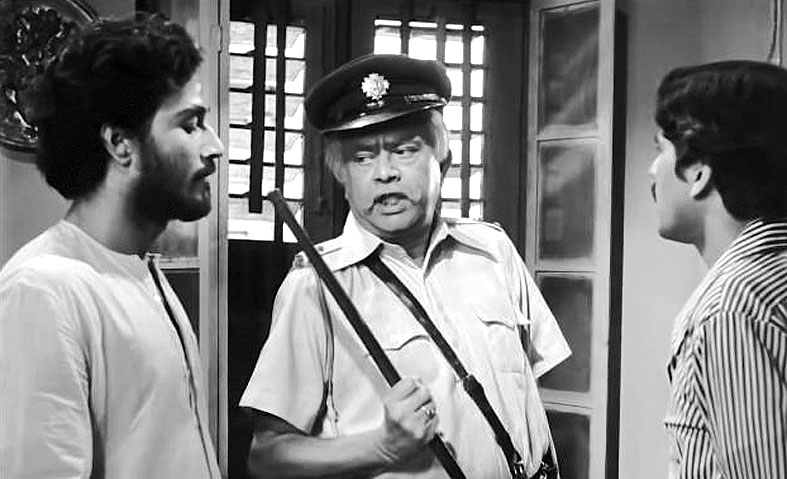
8. In this movie, Bhanu Bandyopadhyay represented the system and all that is wrong with the system. Cine lovers still remember him saying in his caustic tone – ‘In the Indian penal code, the father is not hanged for a murder committed by the son!’ This movie launched another very talented actor who is present in this scene. Who was this actor?
Sourced by the TelegraphNo it was not Santu Mukhopadhyay. Santu debuted in Sansar Simante. It was Bhishma Guhathakurta, whose first appearance on the title credit was as a child artiste in Ajay Kar’s Grihaprabesh at the age of five. Guhathakurata is known for his performance in movies like Banchharamer Bagan, Ganashatru, Atanka among other notable ones.
All of them played the same character in the different versions of the Tapan Sinha classic Golpo Holeo Sotti. Asrani did the role in Bawarchi. Komal did it in the Kannada movie #73, Shanthi Nivaasa. Bhanu Bandyopadhyay played the role of the musician Chhotokhoka in the Bengali version.
Nirdharito Shilpir Anuposthitite. Bhanu Bandyopadhyay’s wife Nilima Bandopadhyay and daughter Basabi Ghatak released Bhanu’s lost film Nirdharito Shilpir Onuposthitite on DVD in 2011.
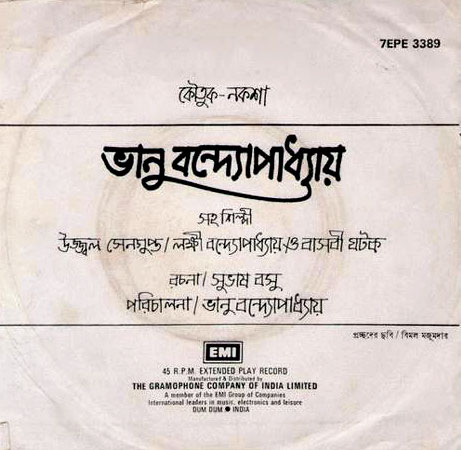
11. This is one of his last comedy albums. In this hilarious satire he draws parallel between King Dasharatha and modern day politics. King Dasharatha promised, but his sons had to suffer by fulfiling it. Similarly, modern day politicians make promises and expect the voters to suffer in a bid to fulfil them. What is the title of this album?
Sourced by the TelegraphNaba Ramayan
On the extreme left is Nabadwip Haldar, who became famous for his Laurel Hardy act with Shyam Laha. In the middle is Jiben Bose, who graced the Bengali film industry for five decades as a character actor. This is a scene from Swarga Martya, directed by Asim Pal.
Focus on remakes
During the 60s and early 70s, several successful Bengali movies were remade in other languages. This section is on some of the movies of Bhanu Bandyopadhyay which were remade.
You had to look at the posters of the remade movies and guess the original Bengali film
Pasher Bari was made in 1952, based on the short story of the same name by Arun Chowdhury. The most notable remakes were Padosan in Hindi in 1968 and Aduthu Veettu Penn in Tamil in 1960. Pasher Bari made Sabitri Chatterjee a star in her own right.

The Indian Express said about this Tamil remake of the Bhanu Bandyopadhyay starrer: “A hilarious comedy in the best tradition of Tamil genius has been brought to the screen by the plucky Producer-Director C. Pullayya … ” One wishes the review had also traced back the history of the movie to a 19th century Bengali story. Which was the Bengali movie?
Sourced by the TelegraphWhen Jomaloye Jibonto Manush was made in 1958, Bhanu Bandyopadhyay was already a popular name with Bengali cine-goers. The film furthered his image as a comedian, who could be a lead actor too. The notable remakes were Devanthakudu (Daredevil) in Telugu in 1960 and Naan Kanda Sorgam (My Heaven) in Tamil in the same year. Devanthakudu had NTR in the lead role. The story was written by dramatist Dinabandhu Mitra of Neeldarpan fame.
Tapan Sinha’s Apanjan won many accolades including the National Award in 1968 for the Best Feature Film in Bengali and several Bengali Film Journalists’ Association awards. The scene where a young group of people sang a Rabindrasangeet about hope and light in the middle of a dark night is an iconic one. Mere Apne was the first directorial venture of Gulzar. It was the first movie of Vinod Khanna in a positive lead role and it was Danny’s first movie. Benki Birugali (Fire and Storm) was the name of the nondescript remake in Kannada.
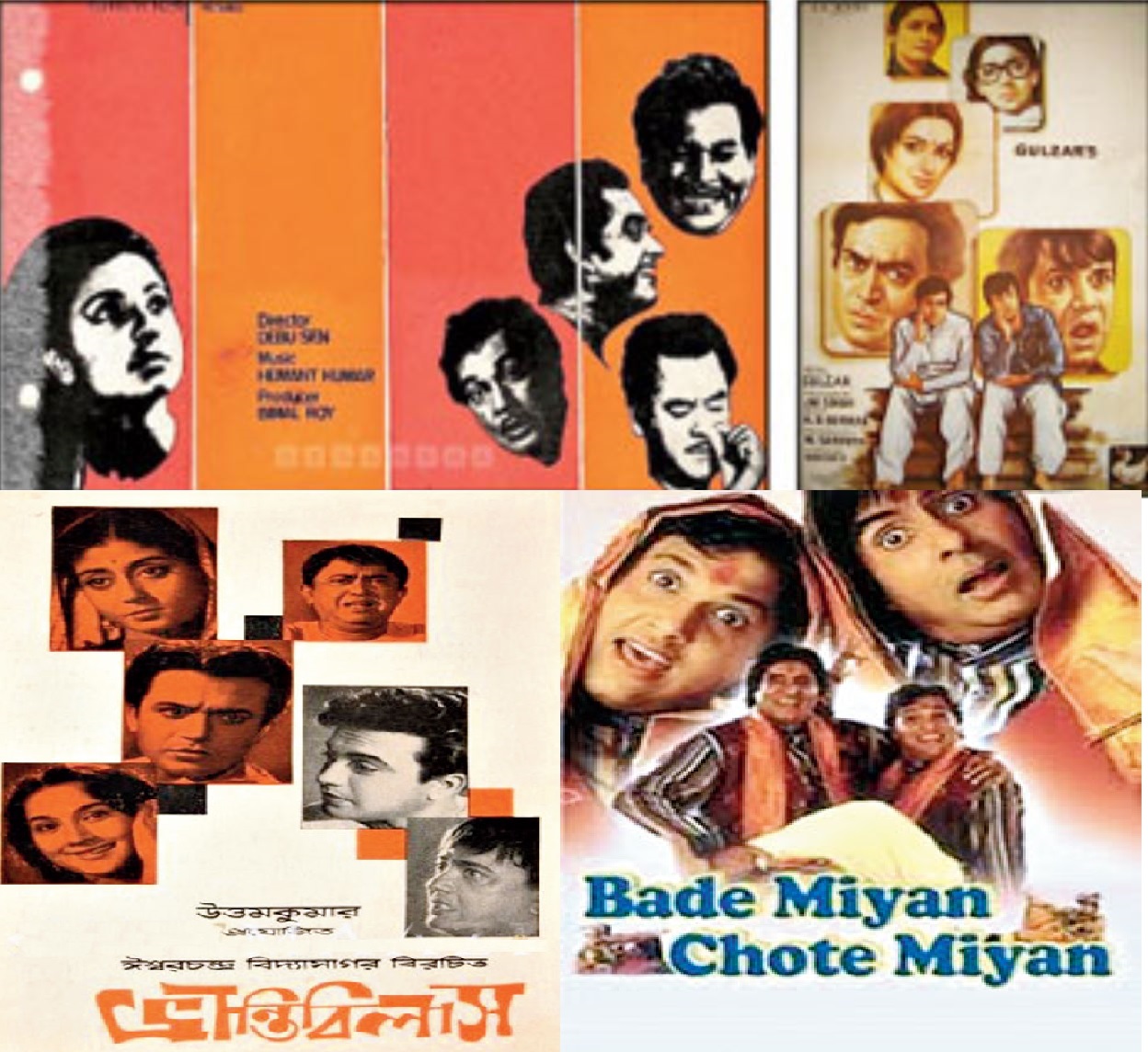
This Bhanu Bandyopadhyay starrer was a superhit in 1963 and earned 300 per cent of the shoe-string budget. Five years later, the first Hindi remake was not a big success despite the presence of the comic man of the season. Years later the writer of the first remake made a second attempt, this time helming the project as a director. This attempt did not miss the bull’s eye. A literary genius and a social reformer cum educationist cum author from the Bengali Renaissance period are associated with these films. Who are they?
Sourced by the TelegraphBhrantibilas, made in 1963 was based on Ishwar Chandra Vidyasagar’s novel of same name. The novel itself was loosely based on William Shakespeare’s The Comedy of Errors. The 1982 remake of Angoor gave Deven Verma his third and last major award as a comedian. Do Dooni Chaar was a remake from 1968 and is remembered more for the beautiful rendition of Hawaon Pe Likhdo than perhaps anything else. However, Bade Miyan Chote Miyan of 1998 remains as a case study of how not to remake a classic.

The Bengali version of this film received President’s Silver Medal in National Film Award for Best Feature Film in Bengali. Bhanu Bandyopadhyay played a stellar role in this movie. It was remade in three different languages and one of them launched Daisy Irani as a child actor. She went ahead to become the most popular child actor of her times and also acted in the Tamil remake. What was the Bengali movie and its Hindi remake?
Sourced by the TelegraphChhele Kaar, starring Bikash Roy and Arundhati Devi, received the National Award in 1954. The following year it was remade in Hindi as Bandish, which also had a great cast, including Ashok Kumar and Meena Kumari. Three years later, Gemini Ganeshan starred in the Tamil version Yaar Paiyyan (Whose son?)

This cult Bengali movie had several remakes. The posters to the right show the commercially more successful ones in Hindi and Kannada. However, these two remakes were nowhere close to being the classic that an earlier Hindi remake was. There was another mindless remake in Tamil which tried to blend the Bengali movie with My Man Godfrey and landed up creating an avoidable watch. What was the cult Bengali movie we are talking about?
Sourced by the TelegraphThe original was Galpa Holeo Sotti. Hero No. 1 was all that can go creatively wrong and commercially right about remaking a classic. The first Kannada remake was Sakalakalavallaba (Master of all arts) starring Shashikumar, who was known as “Supreme Hero” of Kannada film industry and is a member of the Indian National Congress.
The winner of the quiz is Abhijit Sen of BG Block.
“So many of Bhanu Bandyopadhyay’s films are imprinted in my memory — Ora Thak Odhare, Ashite Ashio Na, Miss Priyangbada, Sare Chuattor... Even now, if I spot any of them being telecast on any channel, I get hooked. I used to do quiz contests in my college days. I had even travelled to Delhi to appear in BBC’s Mastermind India quiz and came second in the round. Bhanu, in my opinion, ranks next only to Tulsi Chakraborty and is at par with Jahar Roy among the comedians in Bengali cinema,” says Sen.
Two other readers who came close to Sen are Koushik Pattanayak of East Enclave, New Town, and Sumitra Sinha Chowdhury of CL Block
